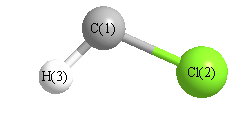Jump to
S2C1
Energy calculated at CCSD(T)/aug-cc-pVTZ
| | hartrees |
|---|
| Energy at 0K | -498.236774 |
| Energy at 298.15K | -498.236637 |
| HF Energy | -497.854918 |
| Nuclear repulsion energy | 38.550059 |
The energy at 298.15K was derived from the energy at 0K
and an integrated heat capacity that used the calculated vibrational frequencies.
Geometric Data calculated at CCSD(T)/aug-cc-pVTZ
Point Group is Cs
Cartesians (Å)
| Atom |
x (Å) |
y (Å) |
z (Å) |
|---|
| C1 |
0.045 |
1.199 |
0.000 |
| Cl2 |
0.045 |
-0.507 |
0.000 |
| H3 |
-1.041 |
1.430 |
0.000 |
Atom - Atom Distances (Å)
| |
C1 |
Cl2 |
H3 |
| C1 | | 1.7059 | 1.1107 |
Cl2 | 1.7059 | | 2.2211 | H3 | 1.1107 | 2.2211 | |
 More geometry information
More geometry information
Calculated Bond Angles
| atom1 |
atom2 |
atom3 |
angle |
|
atom1 |
atom2 |
atom3 |
angle |
| Cl2 |
C1 |
H3 |
102.031 |
|
Electronic energy levels
Charges, Dipole, Quadrupole and Polarizability
Jump to
S1C1
Energy calculated at CCSD(T)/aug-cc-pVTZ
| | hartrees |
|---|
| Energy at 0K | -498.227240 |
| Energy at 298.15K | -498.227089 |
| HF Energy | -497.879246 |
| Nuclear repulsion energy | 38.901815 |
The energy at 298.15K was derived from the energy at 0K
and an integrated heat capacity that used the calculated vibrational frequencies.
Geometric Data calculated at CCSD(T)/aug-cc-pVTZ
Point Group is Cs
Cartesians (Å)
| Atom |
x (Å) |
y (Å) |
z (Å) |
|---|
| C1 |
0.036 |
1.156 |
0.000 |
| Cl2 |
0.036 |
-0.514 |
0.000 |
| H3 |
-0.838 |
1.795 |
0.000 |
Atom - Atom Distances (Å)
| |
C1 |
Cl2 |
H3 |
| C1 | | 1.6698 | 1.0829 |
Cl2 | 1.6698 | | 2.4684 | H3 | 1.0829 | 2.4684 | |
 More geometry information
More geometry information
Calculated Bond Angles
| atom1 |
atom2 |
atom3 |
angle |
|
atom1 |
atom2 |
atom3 |
angle |
| Cl2 |
C1 |
H3 |
126.127 |
|
Electronic energy levels
Charges, Dipole, Quadrupole and Polarizability
